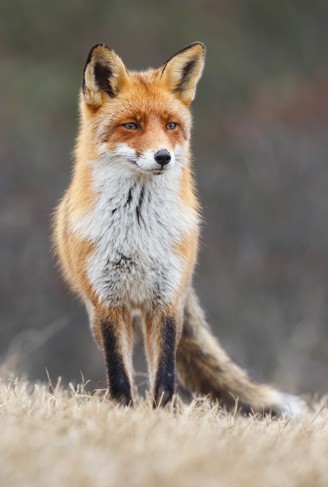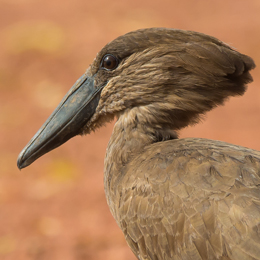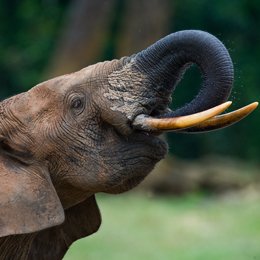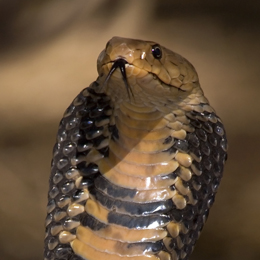Physical Characteristics and Subspecies
As the name clearly indicates, a typical Red Fox is orange-red in color. However, due to the wide range of distribution, several geographical variations and color mutations do exist among various subspecies of V. vulpes.
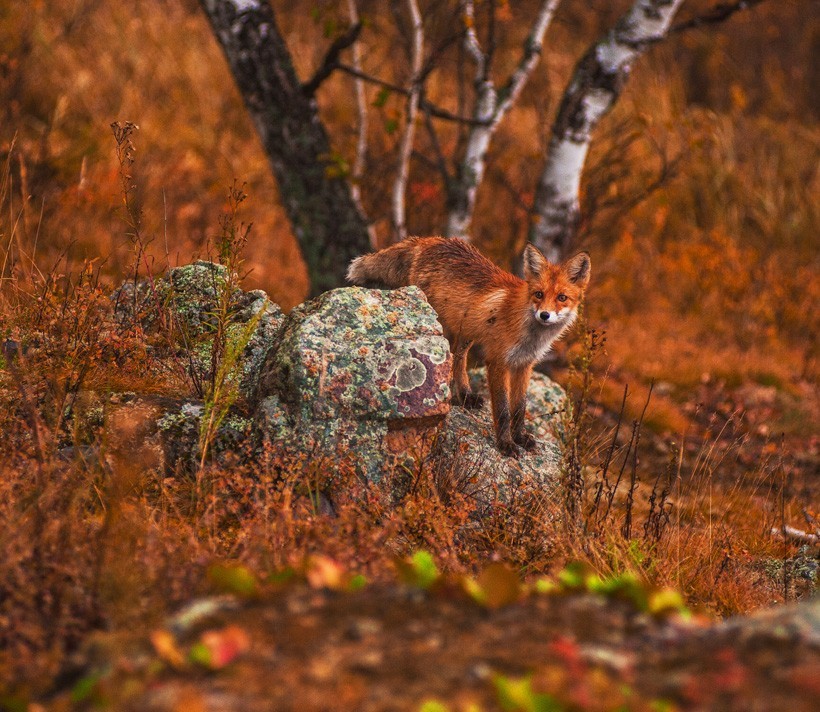
Red Fox in autumn, Taiga
?
Image credits: Olinchuk/Shutterstock
Moreover, just like Leopards and Jaguars, Red Foxes are known for melanism, a condition where the fur displays access levels of dark pigmentation. The two common forms of melanistic Red Foxes are known as Silver and Cross Foxes. The Silver Foxes have a dark black and white color while the Cross Foxes display a combination of red-orange and black color on their fur.
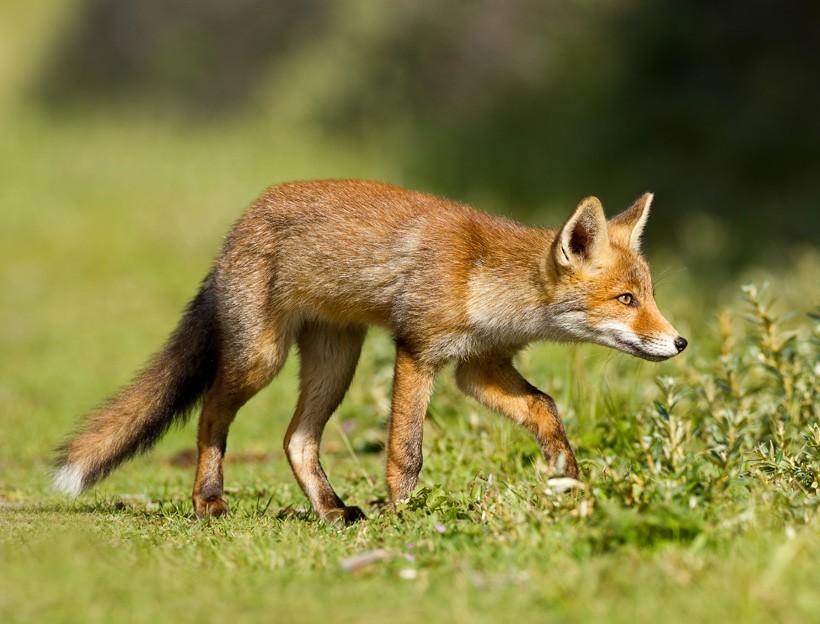
Red Fox hunting
?
Image credits: Menno Schaefer/Shutterstock
Over 45 subspecies of Red Foxes are recognized as of 2005 and based on their color variations and other differences, the Red Foxes are known by several different names.
Some of the most distinct, yet commonly occurring subspecies of V. vulpes are:
- V. v. vulpes: The nominate subspecies V. v. vulpes is also known as the Scandinavian Red Fox. They have a bright red-orange colored fur, with pale yellow color on the back and a bushy long tail.
- V. v. alascensis: Commonly known as the Northern Alaskan Fox, this subspecies larger and the fur is golden brown in color.
- V. v. arabica: This subspecies, also known as the Arabian Red Fox, is commonly found in the Arabian deserts. Well-adapted to survive in the desert, the Arabian Red Fox is smaller than the nominate Red Fox subspecies and has larger years. However, the fur color is quite similar to typical Red Foxes.
- V. v. fulvus: V. v. fulvus is commonly found in Canada and eastern U.S and is smaller than the nominated V. v. vulpes. The fur color is dustier and the legs display a combination of white and dark colored hairs.
- V. v. harrimani: Also known as the Kodiak Red Fox, this subspecies is native to the Kodiak Islands. Kodiak Foxes are very large and the fur is coarser than that of the nominate subspecies.
- V. v. pusilla: This subspecies is found in the salt range system of Punjab and Pakistan. It is commonly known as the White-footed Fox due to the light colored hairs on its feet.
- V. v. regalis: Commonly known as the Northern Plains Fox, this subspecies is native to North America. It is larger than the nominate subspecies V. v. vulpes. The fur colour is golden brown and legs are black in colour.
Red Foxes are the largest of the true foxes and in most subspecies, the males are typically larger than the females. On average, an adult can have a head-body length of 45 to 90 cm with a tail of 30 to 60 cm in length. The weight ranges from 3 to 12 kg, with subspecies like the Kodiak Red Foxes and Northern Plains Foxes being at the higher end of this weight range.
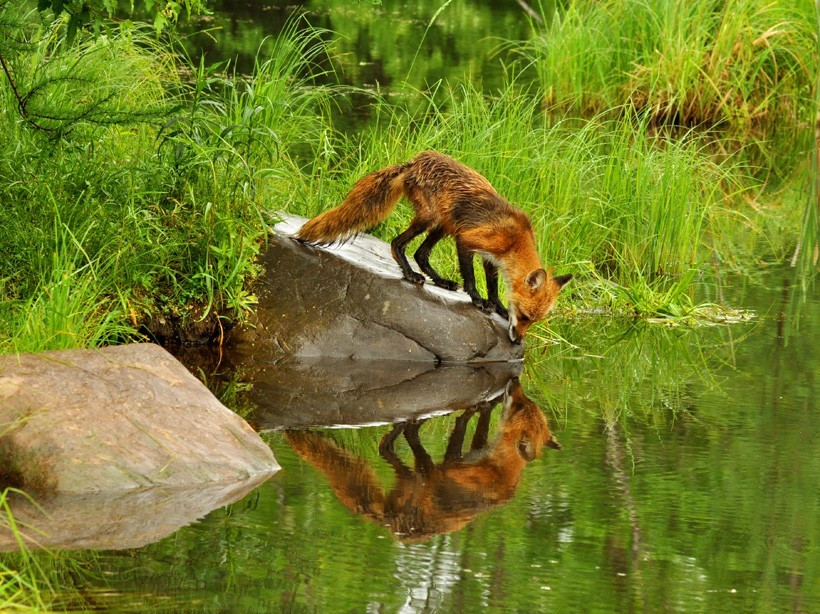
Red Fox, reflections in water
?
Image credits: Betty Shelton/Shutterstock
All Red Foxes have excellent senses of smell and hearing. They detect sounds and scents in order to find food in their habitat. The large pointed ears can pick up low-frequency sounds made by rodents and other burrowing animals living under the ground, while the well-developed nose helps the Red Fox to sense the smell of dead carcasses from large distances. On average, the life expectancy of a Red Fox is up to 3 to 5 years; however, they can live a lot longer in captivity.
Habitat and Lifestyle
The Red Fox occupies the entire northern hemisphere on earth. Hence, they have been observed living in various different types of biomes such as forests, grasslands, deserts and woodlands. Apart from unforgiving natural settings like the Arctic tundra, the Red Fox can be seen living surprisingly close to human settlements and farmlands as well. It seems that their remarkable intelligence and omnivorous dietary habits allow them to survive efficiently, even under the most difficult circumstances.
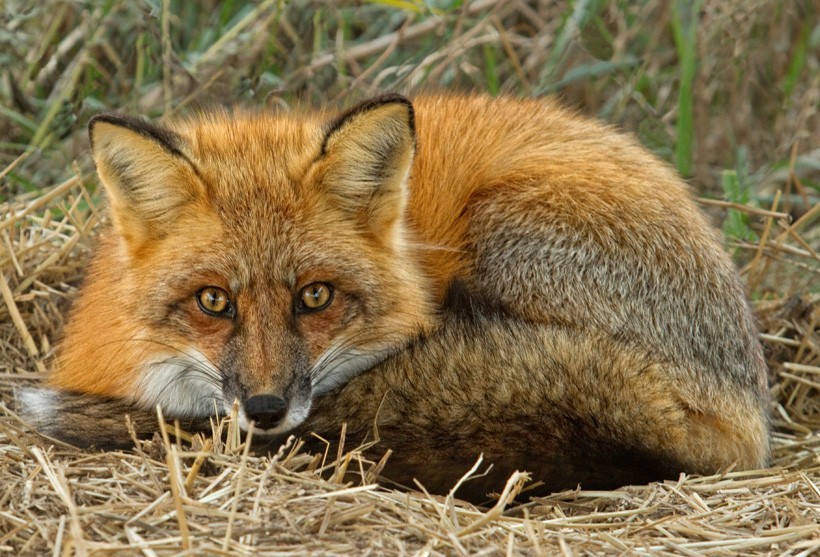
They find bushes and shades to rest and cool off during the day.
?
Image credits: Cynthia Kidwell/Shutterstock
Only the mating pairs have been observed making dens while other Red Foxes often prefer to rest in open areas. They find bushes and shades to rest and cool off during the day. Based on observations of captive individuals, a Red Fox sleeps for up to 10 hours every day and most of the activity is observed during the night.
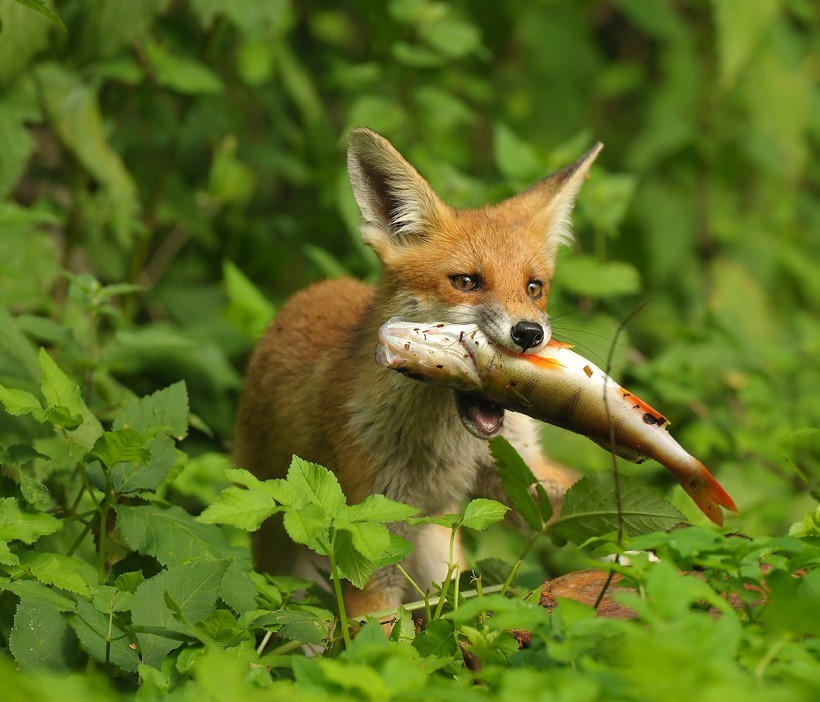
Red Fox eating fish
?
Image credits: grusgrus444/Shutterstock
While foraging and feeding, a Red Fox may walk several miles every day. It depends on different types of food sources such as Mice, Ground Squirrels, Hares, Raccoons, Hamsters, birds, eggs, insects, berries, fruits and grass.
While hunting, Red Foxes depend on their large pointed ears. They listen to small sounds made by rodents or other small animals in order to locate their position. Once found, the Red Fox quietly moves as close as possible to its potential prey. At the right moment, it pounces or chases to catch. To meet their requirement of meat, Red Foxes also frequently scavenge on dead carcasses left behind by other predators in their range.
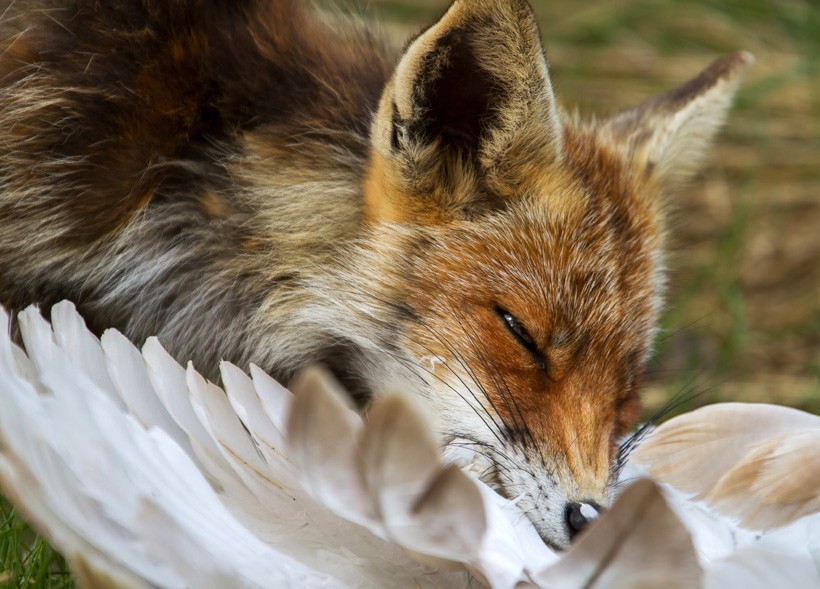
Red Fox eating a bird
?
Image credits: Menno Schaefer/Shutterstock
Due to its wide range of distribution, the Red Fox faces several large predators. Predators like Lions, Tigers, Hyenas, Wolves, Mountain Lions, Leopards and Eagles are all capable of killing the small Red Fox easily. Larger predators often eliminate smaller predators like Red Foxes in order to reduce predator competition in their range. However, the Red Foxes use their wits and cunningness to overcome such situation. They carefully keep a track of other predators in their range and maintain a safe distance from them at all times.
Hence, despite the numerous threats and difficulties, the Red Fox survives and flourishes due to its adaptability and intelligence.
Reproduction and Lifecycle
Most adult Red Foxes mate between December and April and the pups are born during spring when there is an abundance of food sources available. Female Red Foxes are called vixens and have an estrus period of up to three weeks. During this period, males and females form monogamous pairs for several days in the den. After copulation, the vixen undergoes a gestation period of 50 to 60 days where after it gives birth to a litter of 2 to 12 kits.
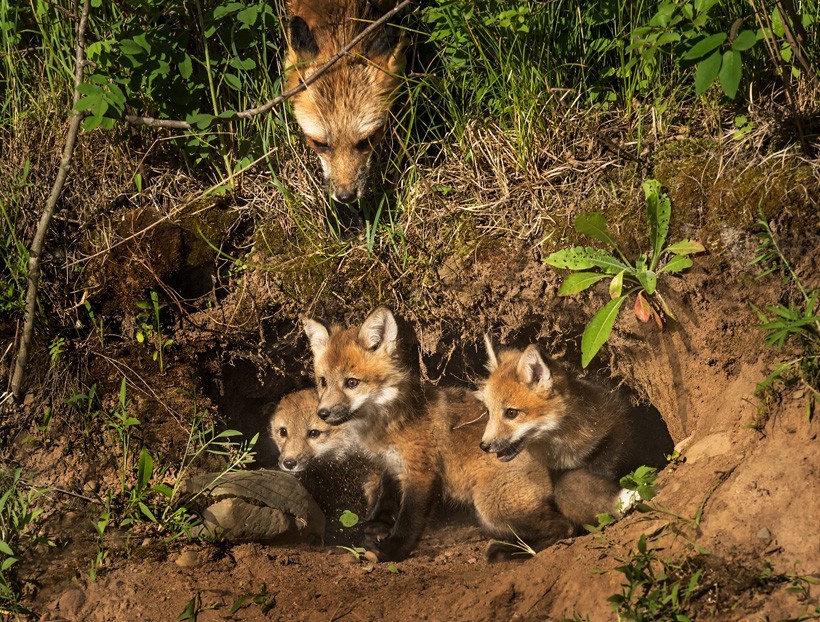
Red Fox kits in a den, mother watching from above
?
Image credits: Geoffrey Kuchera/Shutterstock
The kits are small and weighing only 55 to 110 grams at birth. Within the first two weeks, the kits are unable to see or hear as they are born with closed eyes and ear canals. During this period, the vixen stays inside the den while the male forages and bring in food. The kits are completely dependent on mother’s milk for up to a month after birth. Between 3 to 4 weeks, the kits become strong enough to move out of the den and begin eating small proportions of solid foods. They are completely weaned only when they are up to 7 to 8 weeks old. Red Fox kits grow very quickly. They reach adult size in just 7 months and reach sexual maturity between 8 to 10 months of age.
In the safety of the den, the kits have a better chance of survival. When left unguarded, the small kits may become an easy meal for predators like Snakes, Wolves, other Foxes and birds of prey. Hence, the vixen never leaves the den for the first few weeks and protects the pups aggressively.
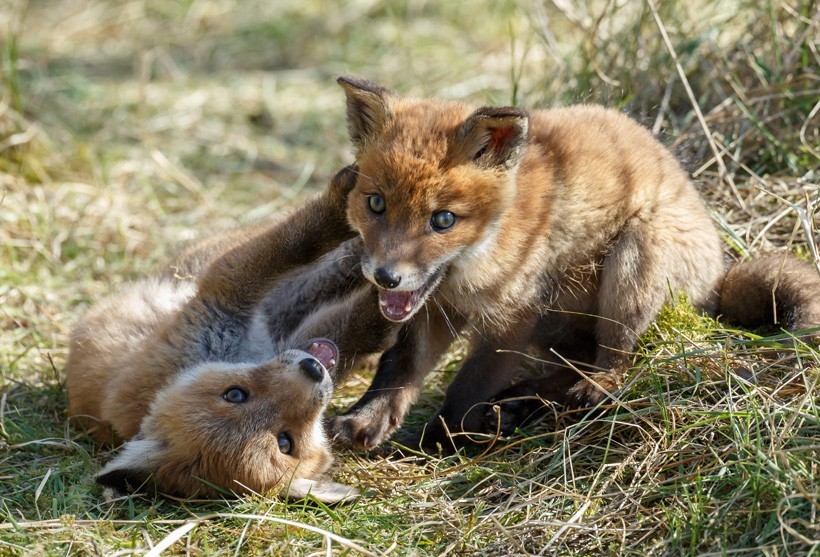
Red Fox cubs playing
?
Image credits: Menno Schaefer/Shutterstock
Even if the kits manage to reach adulthood, life is not easy for Red Foxes in the wild. The lifespan of wild Red Foxes is only 3 to 5 years, whereas, in captivity, they are capable of living up to 15 years.
There have been several unconfirmed reports of hybrids between Dogs and Foxes. Such hybrids are called Doxes. A hybrid between a Red Fox and an Arctic Fox is also possible, though they existence in the wild is unconfirmed. Captive Red Arctic Fox hybrids have been observed displaying mixed characteristic of both species. There have been reports that such hybrid Red Foxes tend to grow quicker, larger and become more aggressive than either of the two species.
Behavior, Communication, and Intelligence
Like most canids, Foxes are social animals living in family groups consisting of mothers, siblings and kits. Such a group of Foxes is called a skulk, leash or a pack. However, unlike other canids, Foxes do not hunt in groups nor do they obey any definite hierarchical system. Most Foxes hunt by themselves, but both males and barren females take the responsibility of bringing back food for mother and pups. Fox packs are quite flexible with no definite hierarchy; individuals may forage far away and they are allowed to reunite even after several days. Red Foxes mark their territory by urinating on tree trunks, rocks bushes and other objects in its range. They have been observed using several different postures for urinating in order to mark their location of choice.
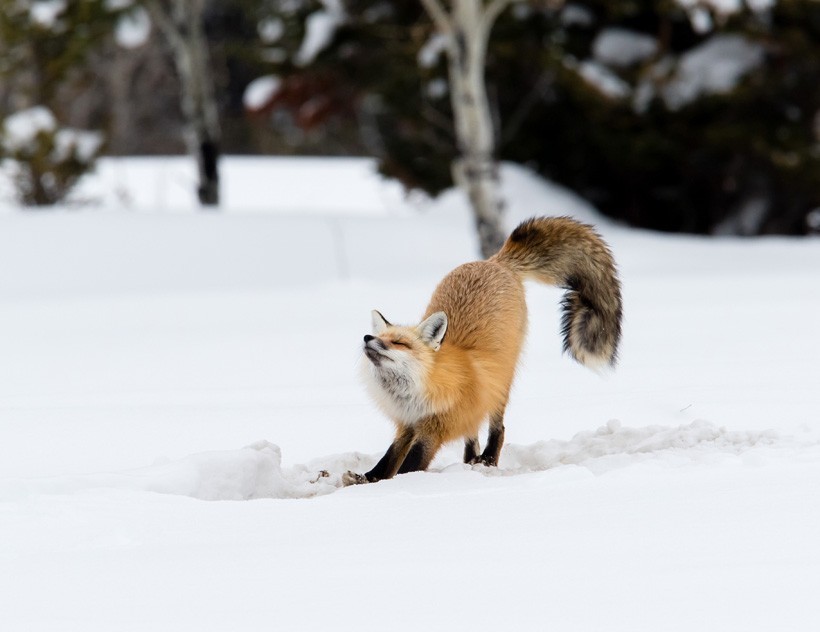
Red Fox in the snow
?
Image credits: Ronnie Howard/Shutterstock
Red Foxes are quite shy in nature. They keep a safe distance from humans and other predators. Most of the activity is seen after sunset and before dawn; during this time, the foxes forage and hunt for food while they rest during the sunny day. Red Foxes use their body language and a wide range of vocal calls in order to communicate with other Red Foxes.
The high-pitched whines and shrieks can be heard frequently within the family. However, while confronting other individuals, they often use barking sounds to intimidate each other. Growls, huffs, mourns are sounds of other frequently used vocal sounds by Red Foxes. On the other hand, body languages are more often used to express emotions like playfulness, aggression, submission and fear. This sophisticated set of communication skills, body languages and the flexible pack formation clearly indicate a high level of intelligence of this species. They display extraordinary understanding while approaching a dead carcass and are capable of stealing a meal from even the top predators.
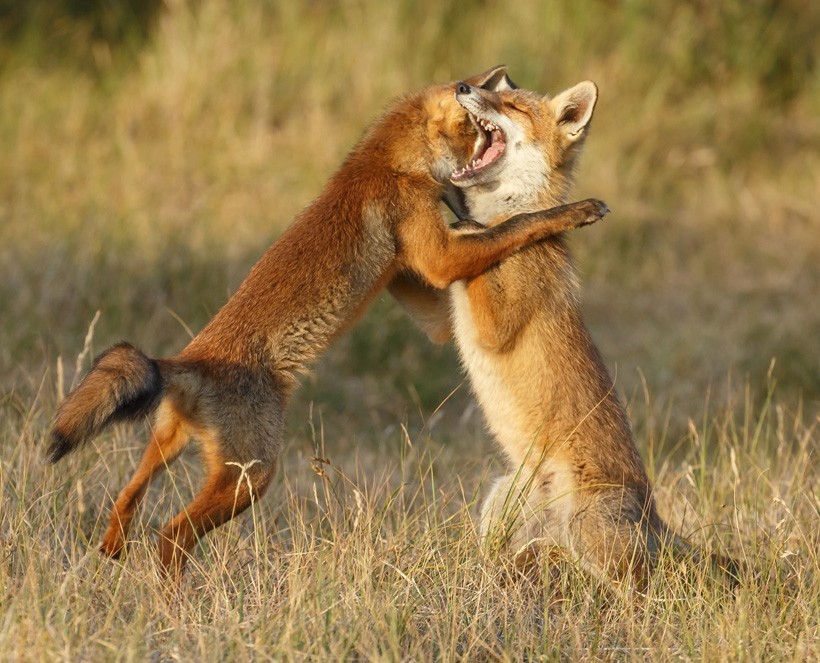
Red Fox juvenile fighting
?
Image credits: Menno Schaefer/Shutterstock
Hence, despite the small size and lack of strength, the Red Foxes are surviving more efficiently than other larger and stronger animals due to their remarkable level of intelligence and resourcefulness.
Population and Distribution
Red Foxes are the most widespread species of the order Carnivora. Covering over 70 million square kilometers, Red Foxes are native to more than 80 different countries. Unsurprisingly, the species V. vulpes is categorized as least concern species on the IUCN RED LIST.
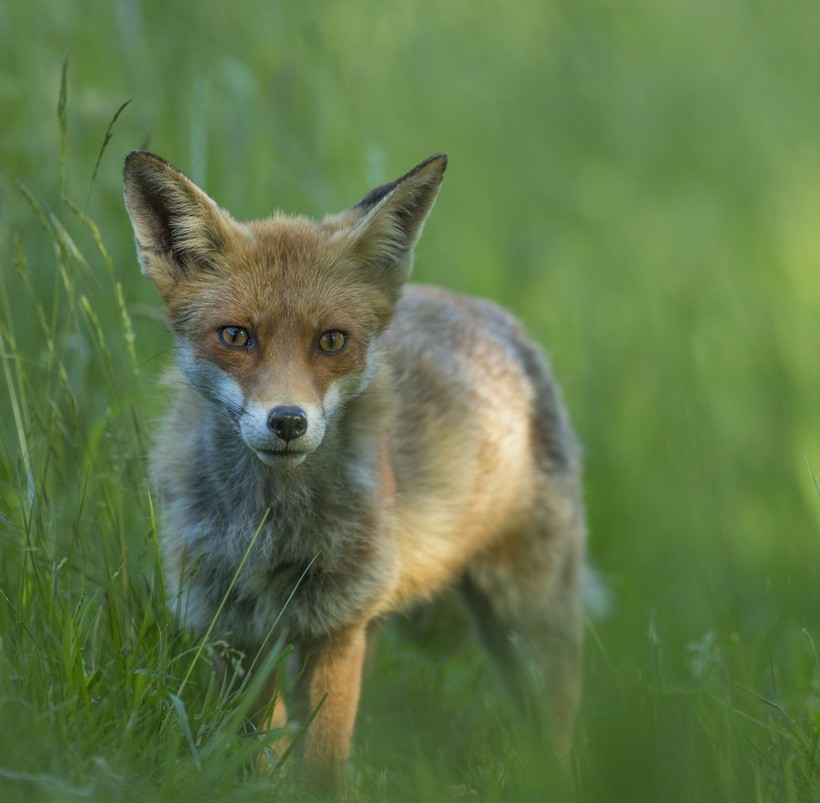
Covering over 70 million square kilometers, Red Foxes are native to more than 80 different countries.
?
Image credits: Jamie Hall/Shutterstock
Their geographical range is distributed across the northern hemisphere. Red Foxes are found in every country, starting from the Northern Arctic Circle to Asia, Northern Africa, and Central America in the South. Red Foxes tend to avoid extreme temperatures and hence, they are not found in places like Sahara, Siberia, Arctic Islands and Iceland.
In Australia, Red Foxes were introduced by the British in the 1830s, primarily for the traditional sport of fox hunting. By the year of 2012 researchers estimated their population to be over 7.2 million. Due to its invasive nature, import of Red Foxes is prohibited in New Zealand. In the Hazardous Substances and New Organisms Act of 1996, the species V. vulpes was categorized as a “prohibited new organism’ as its introduction could possibly harm other native creatures on the small islands of New Zealand.
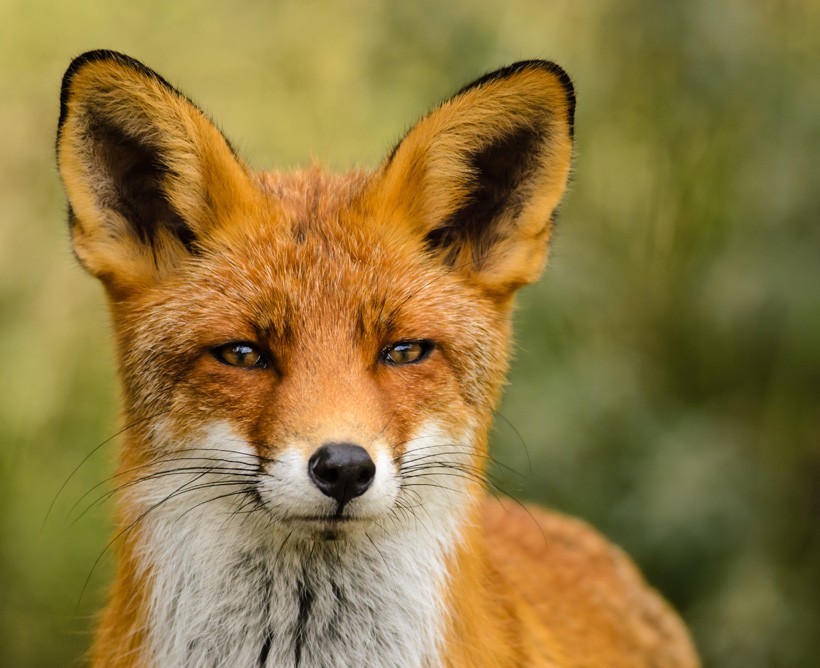
Red Fox close up head
?
Image credits: Richard Guijt Photography/Shutterstock
Across its wide range, Red Foxes are hunted and seen as pests in many regions. However, the population as a whole has no threats so far.
Evolution
Red Foxes belong to the family of canids or dog-like carnivores. The oldest fossils found of such dog-like creatures were up to 40 million years old. From the early canids, the species vulpes evolved approximately 9 to 10 million years ago. Later on, one of the many species of genus Vulpes evolved into the modern V. vulpes. The oldest fossils indicate that the modern V. vulpes came into existence between 3.5 and 1.8 million years ago.
Scientist suspect that the V. vulpes have evolved from Eurasian Foxes like V. v. alopecoides or V. v. chikushanensis. The fossil evidence clearly proves that the ancestors of Red Foxes, as well as the early Red Foxes, were quite smaller in size compared to their modern descendants.
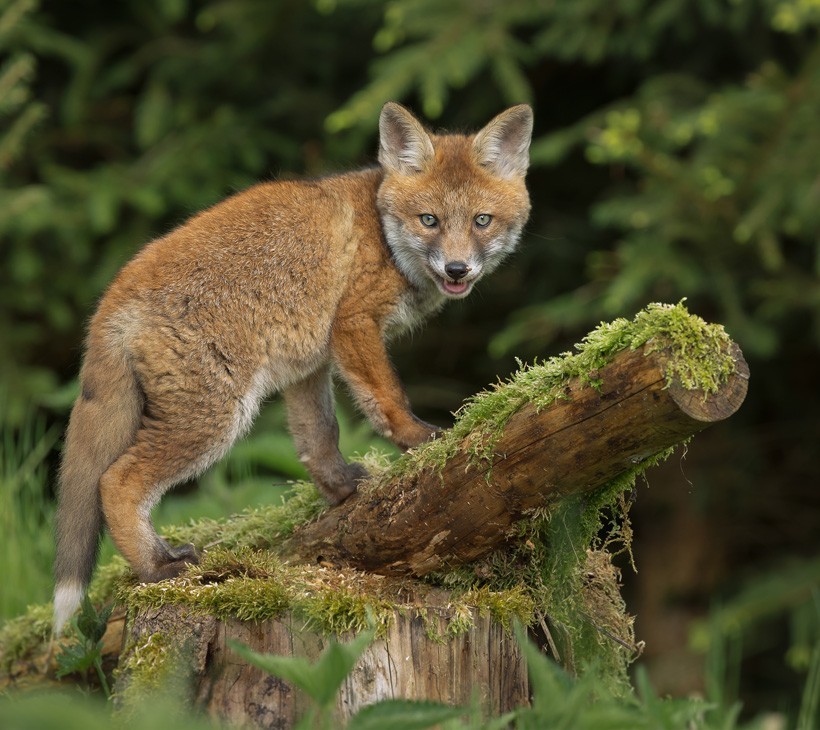
Young wild fox in a forest
?
Image credits: Neil Burton/Shutterstock
Later on, the species V. vulpes spread from Eurasia and colonized in Northern America during the Illinoisan and Wisconsinan glaciations. Over the course of time, several subspecies evolved according to the geographical conditions of their habitat. As of now, over 45 different subspecies of V. vulpes are found in different parts of the world and there is a strong possibility for the existence of even more subspecies.
Funfacts
- Red Foxes are distributed across the entire northern hemisphere where they have the widest range of distribution among carnivores.
- Red Foxes live in packs but they hunt individually.
- Males and barren females bring back food for mother and kits.
- Despite years of hunting, the population of Red Foxes is increasing in number.
- Red Foxes avoid extreme temperatures and hence do not live in deserts and arctic areas.
- There are over 45 subspecies of Red Foxes around the world.
- Once introduced by the British in the 1830s, Red Foxes flourished in Australia. Nowadays their population is estimated to be over 7.2 million.
- New Zealand prohibits import of Red Foxes due to their extremely invasive behavior.
